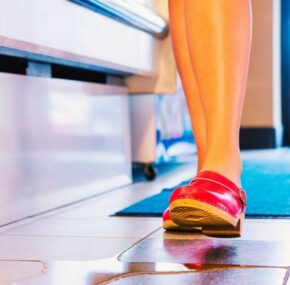Dangerous workplace walkways can cause slip, trip, or fall accidents that leave workers severely injured and unable to work. Walkways without proper slip resistance and safety guardrails account for the highest slip and fall incident rates for construction and industrial workers.

Dangerous Walkways at Work
Slip and falls are the most common type of accident reported by workers. They frequently occur on outdoor and indoor walkways with uneven or slippery surfaces, non-slip-resistant materials, inadequate lighting, and lack of proper safety guardrails. The most dangerous falls occur on walkways or surfaces that are elevated above the main workplace floor, such as roofs, ladders, scaffolds, building girders, and special equipment used in construction and industrial warehouses. When slips and falls happen from a high level, workers can be struck by moving vehicles, moving job site machinery and equipment, or caught between obstacles below. Construction workers, maintenance workers, and utility workers performing jobs at high elevations are especially vulnerable to slip and fall accidents that prove fatal.
According to the Occupational Safety and Health Administration (OSHA), many slip and fall accidents from elevated walkways are caused by unsafe or absent guardrails that are necessary for worker protection. Elevated walkways and platforms must have guardrails that consist of a handrail, a knee-rail that prevents a body from slipping through, a toe-plate that prevents objects from falling through, and a stanchion (vertical post) for support. For workers with ladders on rooftops and elevated platforms, industrial safety gates must be used to protect workers from falls. Industrial safety gates attach to the guardrail. They open easily and close automatically with a spring-loaded mechanism.
Falls to the same level and falls to lower levels are commonly caused by sloping surfaces, uneven surfaces, loose tiles or mats, greasy shoes, and materials with no skid or slip resistance. Workplace slip and falls pose serious injury dangers to workers that often result in:
- Loss of a job or lost wages
- Unexpected medical expenses
- Pain and suffering
- Temporary or permanent disabilities
- Traumatic brain injuries
- Death
Workplace slips, trips, and falls account for 17% of all disabling occupational injuries and 15% of all accidental deaths in the workplace. To prevent slip and fall accidents, serious injuries, and fatalities, OSHA regulations require employers to ensure walkway safety for all workers in the workplace.







